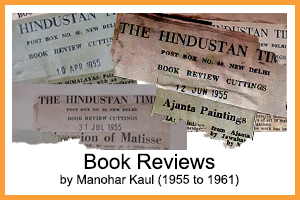
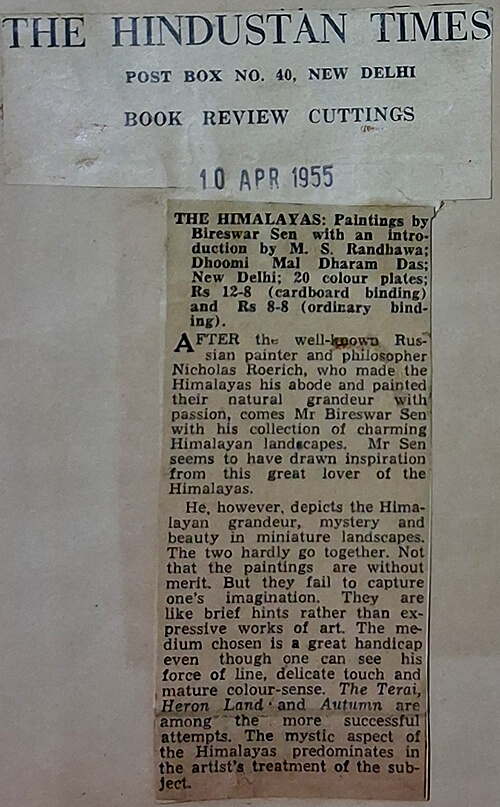
The Hindustan Times, April 10, 1955
The Himalayas: Paintings by Bireswar Sen
With an introduction by M. S. Randhawa. Published by Dhoomi Mal Dharam Das, New Delhi
20 colour plates
Price: ₹12–8 (cardboard binding), ₹8–8 (ordinary binding)
After the well-known Russian painter and philosopher Nicholas Roerich, who made the Himalayas his abode and painted their natural grandeur with great passion, comes Bireswar Sen with his own collection of charming Himalayan landscapes. Mr. Sen appears to have drawn deep inspiration from this earlier master and lover of the Himalayas. However, unlike Roerich’s sweeping and dramatic canvases, Bireswar Sen presents the grandeur, mystery, and beauty of the Himalayas in miniature landscapes. The two approaches are hardly compatible—grandeur and miniaturism. Not that the paintings are without merit, but they fail to capture the imagination in a lasting way. They come across more as suggestive glimpses than as expressive, complete works of art. The miniature format itself proves to be something of a limitation, despite the evident strength in line, delicacy of touch, and mature sense of colour found in many of the works. Among the more successful attempts are The Terai, Heron Land, and Autumn, where the artist’s skill and sensitivity come through more effectively. The mystic quality of the Himalayas seems to dominate Mr. Sen’s treatment, offering a subdued and spiritual interpretation of the mountain landscapes—more meditative than majestic.
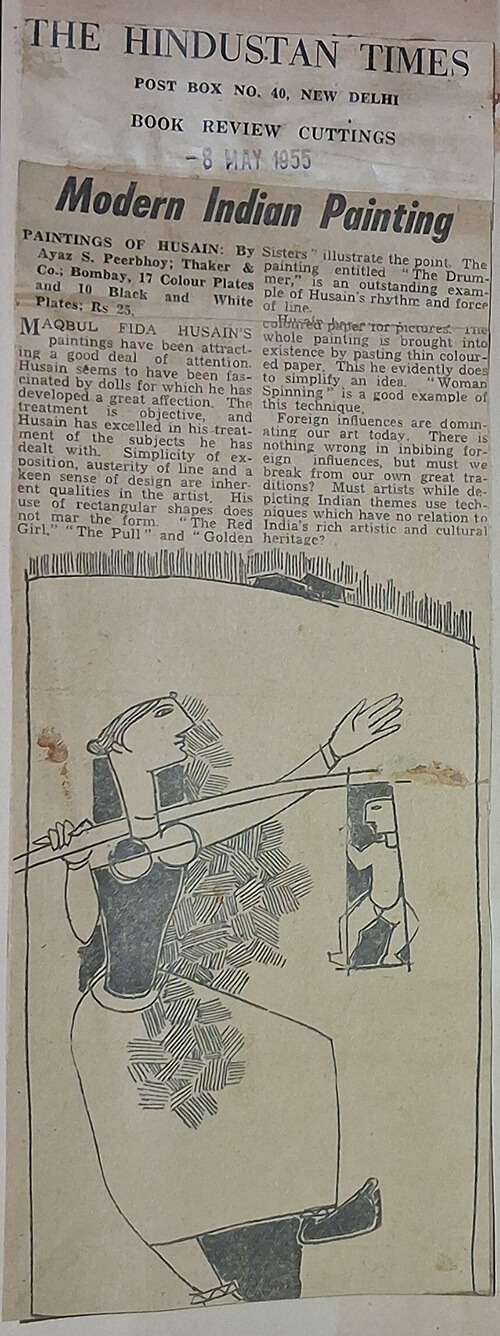
The Hindustan Times, May 05, 1955
MODERN INDIAN PAINTING
PAINTINGS OF HUSAIN
By Ayaz S. Peerbhoy
Published by Thacker & Co., Bombay
17 Colour Plates and 10 Black & White Plates
Price: Rs 25
Maqbul Fida Husain’s paintings have been attracting considerable attention. Husain seems to have developed a great affection for dolls, which he depicts with a striking objectivity. His treatment of subjects is marked by austerity of line, clarity of composition, and a keen sense of design. His frequent use of rectangular shapes does not detract from the expressiveness of form. Works like “The Red Girl”, “The Pull”, and “Golden Sisters” illustrate this point effectively. The painting titled “The Drummer” is an outstanding example of Husain’s rhythmic energy and forceful linework. In several paintings, the entire composition is created by pasting coloured paper—a collage-like technique used to simplify ideas. “Woman Spinning” demonstrates this method effectively. The review also raises a thoughtful concern: Foreign influences are dominating our art today. There is nothing wrong in imbibing foreign elements—but must we break entirely from our own great traditions? Must Indian artists, even when portraying Indian themes, use techniques that have no relation to India's rich artistic and cultural heritage?
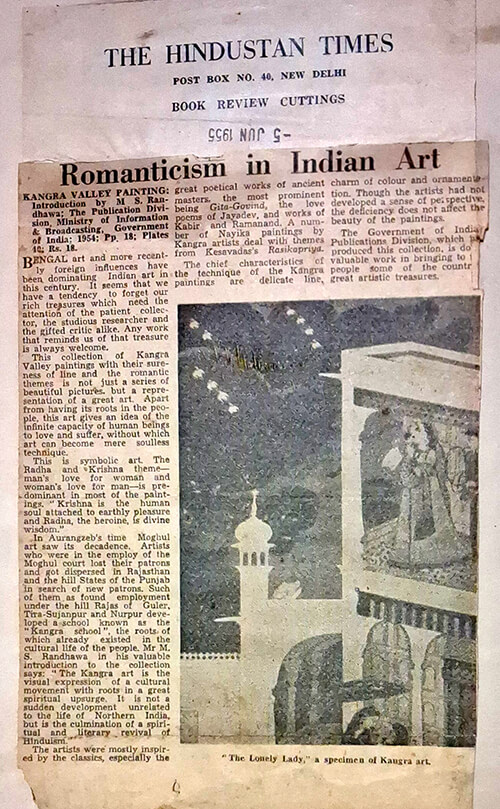
"The Lonely Lady", a specimen of Kangra art.
The Hindustan Times, June 05, 1955
Romanticism in Indian Art
Kangra Valley Painting
Introduction by M. S. Randhawa
Publication Division, Ministry of Information & Broadcasting, Government of India
Pages: 18, Plates: 10
Price: Rs. 18
In more recent times, Bengal art and other foreign influences have dominated Indian painting. It seems that we have a tendency to forget our rich treasures, which need the attention of the patient collector, the studious researcher, and the gifted critic alike. Any work that reminds us of that treasure is always welcome.
This collection of Kangra Valley paintings, with their sureness of line and romantic themes, is not just a series of beautiful pictures, but a representation of a great art. Apart from having its roots in the people, this art gives an idea of the infinite capacity of human beings to love and suffer—without which art can become mere soulless technique.
This is symbolic art. The Radha and Krishna theme—love for woman and woman’s love for man—is predominant in most of the paintings. “Krishna is the human soul attached to earthly pleasure and Radha, the heroine, is divine wisdom.”
In Aurangzeb’s time, Moghul art saw its decadence. Artists who were in the employ of the Mughal court lost their patrons and got dispersed in Rajasthan and the hill States of the Punjab, in search of new patrons. Such of them as found employment under the hill Rajas of Guler, Tira-Sujanpur, and Nurpur developed a school known as the Kangra school, the roots of which already existed in the cultural life of the people.
Mr. M. S. Randhawa, in his valuable introduction to the collection, says:
“The Kangra art is the visual expression of a cultural movement with roots in a great spiritual upsurge. It is not a sudden development unrelated to the life of Northern India, but is the culmination of a spiritual and literary revival of Hinduism.”
The artists were mostly inspired by the classics, especially the great poetical works of ancient masters—the most prominent being Gita-Govinda, the love poems of Jayadev, and the works of Kabir and Ramanand. A number of Nayika paintings by Kangra artists deal with themes from Kesavadas’s Rasikapriya.
Characteristics of the Kangra Style
The chief characteristics of the technique of Kangra painting are:
Delicate line
Great charm of colour
Ornamentation
Though the artists had not developed a sense of perspective, this deficiency does not affect the beauty of the paintings.
The Government of India Publications Division, which produced this collection, is doing a valuable work in bringing to the people some of the country’s great artistic treasures.

The Hindustan Times, June 12, 1955
Ajanta Paintings
Paintings from Ajanta Caves
Preface by Jawaharlal Nehru
Introduced by Madanjeet Singh
Published by
the New York Graphic Soclety
by arrangement with U.N.E.S.C.O.
Pages: 18, Plates: 10
Price: Rs. 18
Ajanta Paintings
The frescoes of Ajanta (1st century B.C. to 7th century A.D.) are part of the artistic and cultural heritage of India. They portray the ancient Indian civilization by representing the pomp and grandeur of royalty. At the same time, they depict with sympathy the life of the common people, affirming the beautiful and spiritual values of life.
Though the religious element has bestowed a tone of devotion, the human emotions, passions, and sentiments are the mainstay of the art of Ajanta. These paintings, with glorious backgrounds and figures perhaps as grand as Michelangelo's paintings in the Sistine Chapel in Rome or Leonardo da Vinci's, reflect a rare synthesis of beauty and spirit.
A striking feature in the technique of the Ajanta paintings is the achievement of high standards of artistic excellence with very simple means. A limited number of colours is used with such blending skill. Though light or dark colour washes are applied to concentrate attention on particular details, the compositions remain so balanced and the figures so gracefully drawn as to present complete harmony in the whole scheme.
The artists of Ajanta, according to some, lacked the sense of perspective. This is not true. The specimens of the 5th century A.D. clearly show that the artists had a good understanding of space and distance. Not only that, but in the sweeps of the brush, the drawing of gradual curves, and in modelling, a mature sensitivity is seen.
Woman has been painted as a princess, a maidservant, a peasant, a nun, and even a dancing girl in various charming poses, but her moral dignity has always been maintained. Besides, in the treatment of decorative work in the form of various subjects depicting birds, animals, flowers, and other motifs, there is a highly developed sense of design and craftsmanship.
The art of Ajanta is great and continues to inspire us. Through it, history becomes human and living, and not merely a record of some lost age which we can hardly understand. Thus, the appeal of Ajanta is not merely to the art expert, but to every sensitive human being.
The format and the print of the book are no doubt impressive as a reproduction of passages. The price, however, is proportionate to the book, as stated in its character. So the seeds of artistic understanding and love of art are sown.
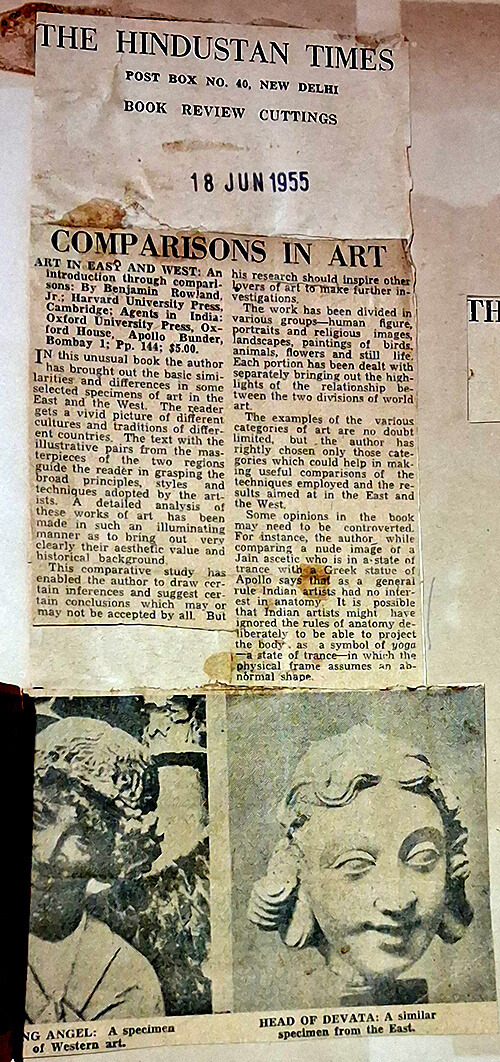
SINGING ANGEL: A specimen from Western art
HEAD OF DEVATA: A specimen from Eastern art
The Hindustan Times, June 18, 1955
COMPARISONS IN ART
Art in East and West: An Introduction Through Comparisons
By Benjamin Rowland
Harvard University Press, Cambridge
Agents in India: Oxford University Press, Oxford House, Apollo Bunder, Bombay 1
Pp. 144; Price: $5.00
In this unusual book, the author has brought out the basic similarities and differences in selected specimens of art from the East and the West. The reader is offered a vivid picture of the diverse cultures and traditions of different countries. The text, along with illustrative pairs drawn from masterpieces of both regions, guides the reader in understanding the broad principles, styles, and techniques adopted by the artists. A detailed analysis of these works of art has been carried out in such an illuminating manner that their aesthetic value and historical background are clearly revealed. This comparative study has enabled the author to draw certain inferences and suggest conclusions which may or may not be universally accepted. But his research should inspire other lovers of art to pursue further investigations. The book is organized into various categories—human figures, portraits and religious images, landscapes, paintings of birds, animals, flowers, and still life. Each section is treated individually, highlighting the relationships between the two streams of world art. While the examples used are limited, the author has wisely selected only those that best facilitate useful comparisons in techniques and the artistic aims of the East and the West. Some opinions in the book may need to be debated. For instance, while comparing a nude image of a Jain ascetic in a state of trance with a Greek statue of Apollo, the author suggests that Indian artists, as a rule, had no interest in anatomy. It is possible, however, that Indian artists deliberately ignored anatomical rules in order to project the body as a symbol of yoga—a trance state—in which the physical form assumes an abnormal shape.
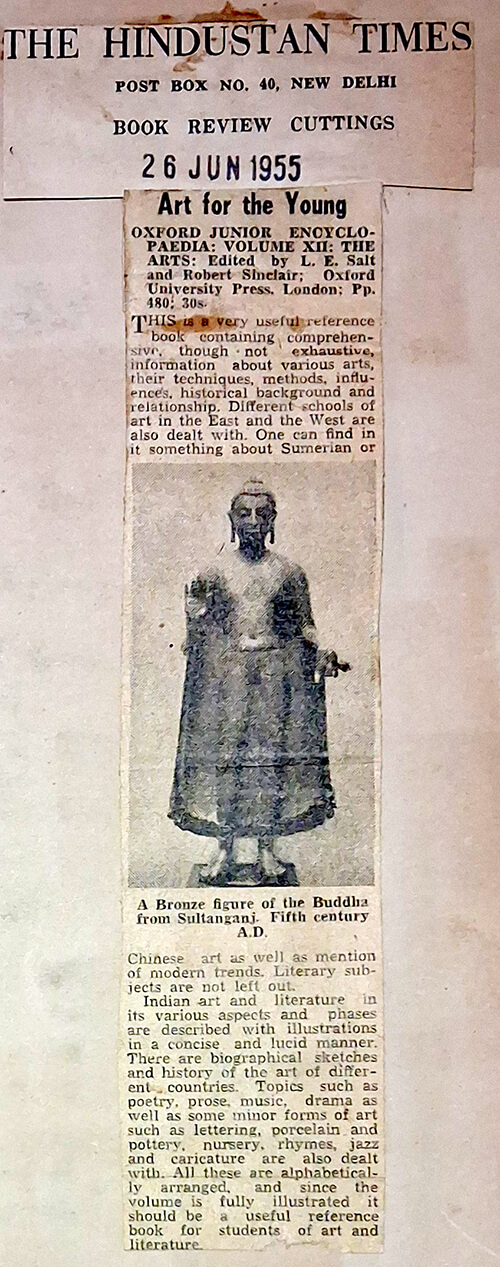
A bronze figure of the Buddha from Sultanganj. Fifth century A.D.
The Hindustan Times, June 20, 1955
Art for the Young
Oxford Junior Encyclopaedia: Volume XII — The Arts
Edited by L. E. Salt and Robert Sinclair
Published by Oxford University Press, London
Pp. 480; Price: 30 shillings
This is a very useful reference book containing comprehensive—though not exhaustive—information about various forms of art, their techniques, methods, influences, historical background, and interrelationships. Different schools of art, both in the East and the West, are discussed. The volume includes entries on subjects ranging from Sumerian and Chinese art to modern artistic trends. Literary subjects are also well represented. Indian art and literature are treated with due care, and their various aspects and phases are described with concise, lucid text and illustrations. The book includes biographical sketches, as well as histories of the art and literature of different countries. A wide range of topics is covered: poetry, prose, music, drama, and even minor art forms like lettering, porcelain and pottery, nursery rhymes, jazz, and caricature. All entries are alphabetically arranged, making the volume easy to use. Fully illustrated throughout, this book should prove a valuable reference for students of art and literature, especially younger readers who are just beginning to explore the field.
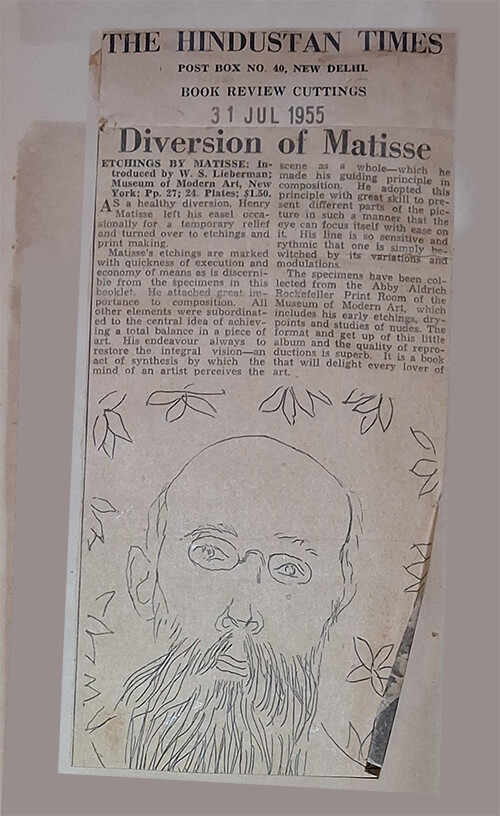
The Hindustan Times, July 13, 1955
Diversion of Matisse
ETCHINGS BY MATISSE
Introduced by W. S. Lieberman
Museum of Modern Art New York
27 pages · 24 plates · $1.50
As a healthy diversion, Henri Matisse would occasionally leave his easel for temporary relief and turn instead to etching and printmaking. Matisse's etchings are marked by a quickness of execution and an economy of means, clearly visible in the specimens included in this elegant booklet. He attached great importance to composition, often subordinating all other elements to the central idea of achieving a total balance in the work of art. His continual effort was to restore the integral vision—an act of synthesis by which the artist perceives a scene as a whole and presents its different parts in a manner that the eye can focus with ease. His lines are so sensitive and rhythmic that one is simply bewitched by their variations and modulations. The specimens have been selected from the Abby Aldrich Rockefeller Print Room of the Museum of Modern Art. This small album includes early etchings, drypoints, and studies of nudes. The format and production quality are superb. It is a book that will delight every lover of art.
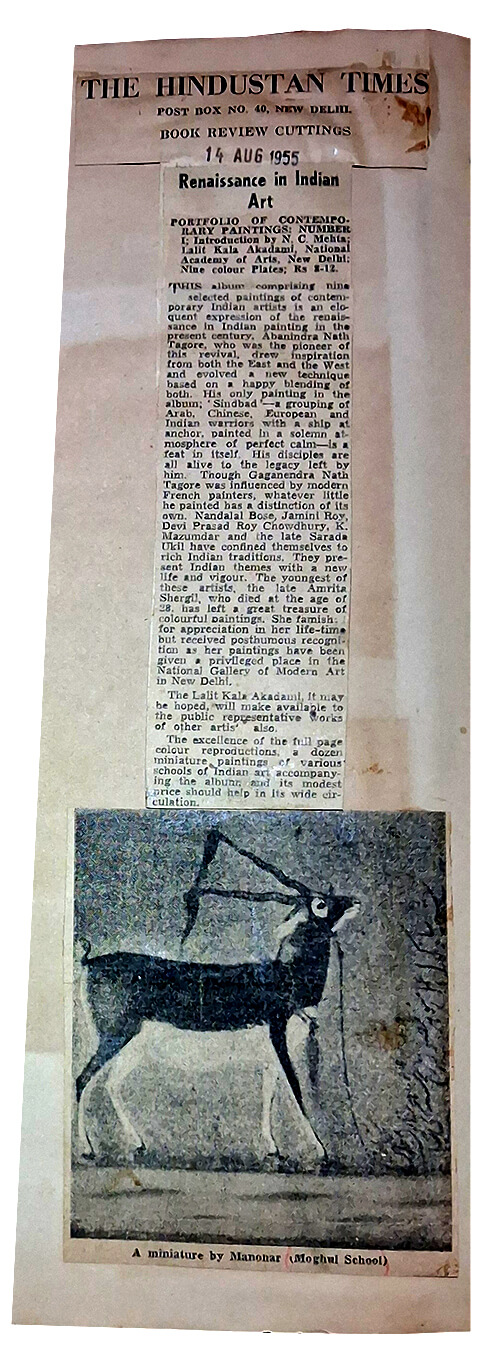
A miniature by Manonar (Moghul School)
The Hindustan Times, August 14, 1955
Renaissance in Indian Art
PORTFOLIO OF CONTEMPORARY PAINTINGS: NUMBER I
Introduction by N. C. Mehta
Lalit Kala Akadami, National Academy of Arts, New Delhi
Nine colour Plates; Rs 8-12.
THIS album comprising nine selected paintings of contemporary Indian artists is an eloquent expression of the renaissance in Indian painting in the present century. Abanindra Nath Tagore, who was the pioneer of revival, drew inspiration from both the East and the West and evolved a new technique based on a happy blending of European and Chinese. His only painting in the album; 'Sindbad'—a grouping of Arab, Indian warriors with a ship at anchor, painted in a solemn atmosphere of perfect calm—is a feat in itself. His disciples are all alive to the legacy left by him. Though Gaganendra Nath Tagore was influenced by modern French painters, whatever little he painted has a distinction of its own. Nandalal Bose, Jamini Roy, Devi Prasad Roy Chowdhury, K. Mazumdar and the late Sarada Ukil have confined themselves to rich Indian traditions. They present Indian themes with a new life and vigour. The youngest of these artists, the late Amrita Shergil, who died at the age of 28, has left a great treasure of colourful paintings. She famished for appreciation in her life-time but received posthumous recognition as her paintings have been given a privileged place in the National Gallery of Modern Art in New Delhi. The Lalit Kala Akadami, it may be hoped, will make available to the public representative works of other artists. The excellence of the full page colour reproductions, a dozen miniature paintings of various schools of Indian art accompanying the album and its modest price should help in its wide circulation.
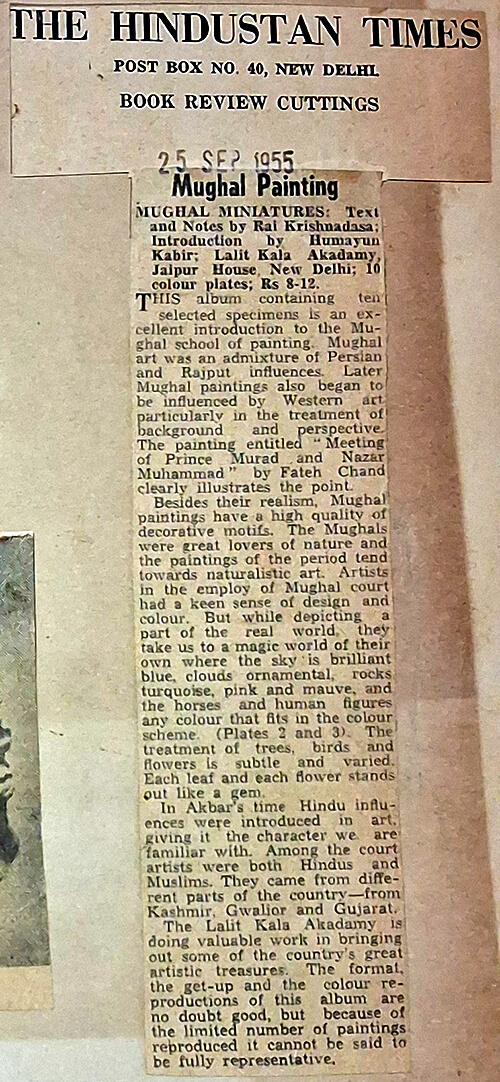
The Hindustan Times, September 25, 1955
Mughal Painting
Mughal Miniatures
Text and Notes by Rai Krishnadasa
Introduction by Humayun Kabir
Published by Lalit Kala Akademi, Jaipur House, New Delhi
10 colour; plates
Price: ₹8–12
This album, containing selected specimens, is an excellent introduction to the Mughal school of painting. Mughal art was an admixture of Persian and Rajput influences. Later Mughal paintings also began to reflect Western influences—particularly in the treatment of background and perspective. The painting titled "Meeting of Prince Murad and Nazar Muhammad" by Fateh Chand clearly illustrates this point. Besides their realism, Mughal paintings exhibit a high quality of decorative motifs. The Mughals were great lovers of nature, and the art of this period tends towards naturalism. Artists employed at the Mughal court possessed a keen sense of design and colour. Yet while they depicted the real world, they also transported the viewer to a magical realm of their own—where skies are a brilliant blue, clouds are ornamental, rocks appear in shades of turquoise, pink, and mauve, and horses and human figures are rendered in any hue that fits the overall colour scheme (see Plates 2 and 3). The treatment of trees, birds, and flowers is subtle and varied. Each leaf and flower stands out like a gem. During Akbar's reign, Hindu influences entered Mughal art, giving it the character with which we are most familiar today. Among the court artists were both Hindus and Muslims, hailing from various regions of India—Kashmir, Gwalior, and Gujarat. The Lalit Kala Akademi is doing commendable work in bringing to light some of the country's great artistic treasures. The format, presentation, and colour reproductions of this album are of high quality.
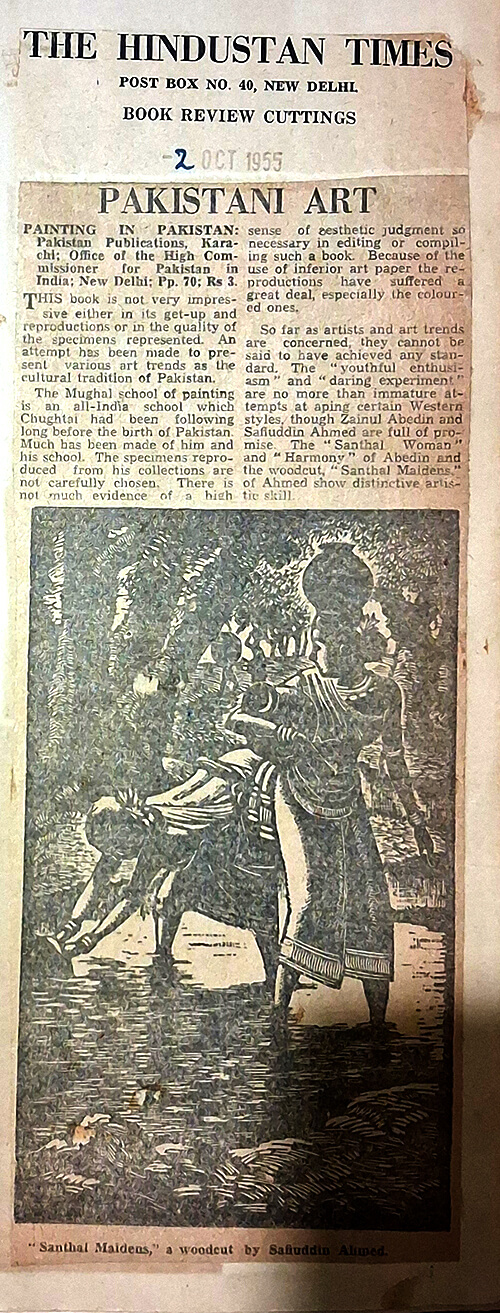
“Santhal Maidens” by Safiuddin Ahmed
The Hindustan Times, October 02, 1955
PAKISTANI ART
PAINTING IN PAKISTAN
Published by Pakistan Publications, Karachi
In association with the Office of the High Commissioner for Pakistan in India, New Delhi
Pp. 70; Price: Rs 3
This book is not very impressive—neither in its physical get-up nor in the quality of reproductions and art specimens represented. Though an effort has been made to present the various art trends reflecting the cultural tradition of Pakistan, the results fall short. The Mughal school of painting, for instance, is an all-India school, which Chughtai had been following long before the creation of Pakistan. Much space is devoted to him and his school, yet the specimens reproduced from his collection are not carefully selected, and reveal no particular merit. There is also a lack of aesthetic judgment in the editing and compilation of the volume. The use of inferior art paper further diminishes the quality of reproduction, especially in the coloured plates. As for the contemporary artists and trends, they cannot be said to have achieved any real standard. Much of what is presented reflects little more than “youthful enthusiasm” and “daring experiment”—often immature attempts to imitate Western styles. Still, there are signs of promise. The woodcut “Santhal Maidens” and “Harmony” by Zainul Abedin, and “Santhal Woman” by Safiuddin Ahmed, exhibit distinctive artistic skill and sincerity of expression.
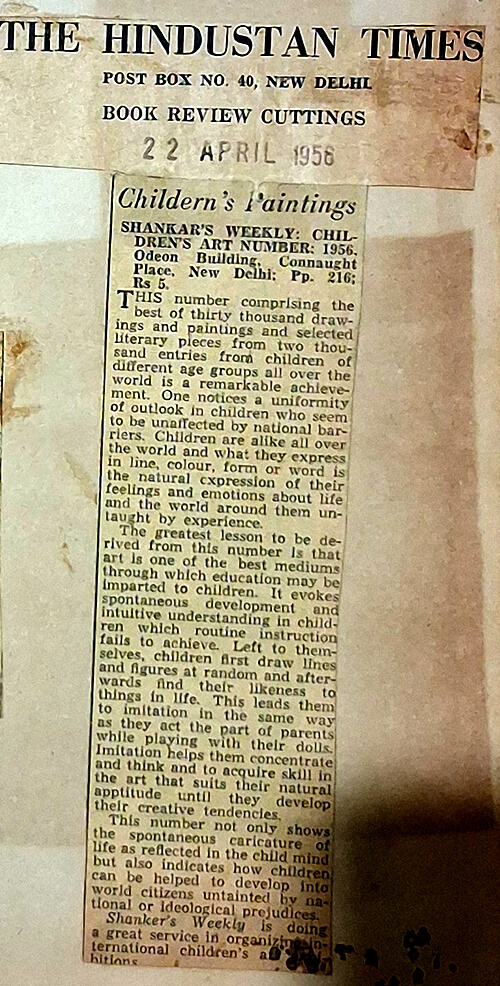
The Hindustan Times, April 04, 1956
Children’s Paintings
SHANKAR’S WEEKLY: CHILDREN’S ART NUMBER, 1956
Published from Odeon Building, Connaught Place, New Delhi
216 pages · Price: ₹5
This special number—comprising the best selections from over thirty thousand drawings and paintings, along with literary pieces chosen from two thousand entries—is a remarkable achievement. These works come from children of various age groups across the globe. One is immediately struck by a uniformity of outlook in these young minds, seemingly unaffected by national boundaries. Children are inherently alike all over the world. What they express—whether through line, colour, form, or words—is a natural and unfiltered expression of their feelings and emotions about life and the world around them, untouched by learned experience or adult conditioning. A key lesson to be drawn from this volume is that art is one of the most powerful mediums for education. It enables spontaneous development and intuitive understanding in children—something formal instruction often fails to elicit. Left to themselves, children instinctively begin by drawing lines and figures at random, and later identify these forms with real things. This visual discovery leads them to imitation, much like how they play-act their parents with dolls. Imitation helps children focus, think, and gain skill in art forms that align with their natural inclinations, eventually enabling them to develop their creative faculties. This issue not only presents a spontaneous caricature of life as seen through the child’s eyes, but also offers insight into how children may be nurtured into becoming world citizens, free of nationalistic and ideological prejudices. Shankar’s Weekly doing a great service by organizing and promoting international children's art exhibitions.
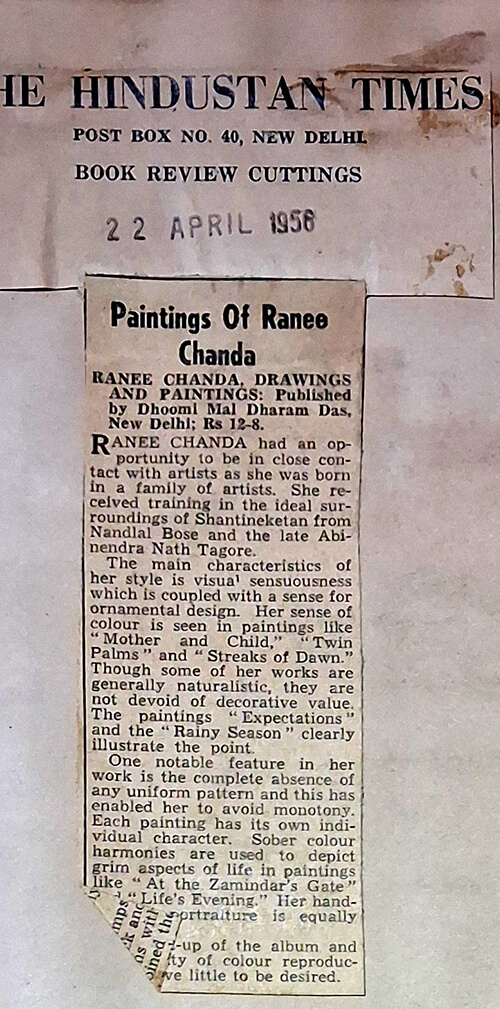
The Hindustan Times, April 22, 1956
Paintings of Ranee Chanda
Ranee Chanda: Drawings and Paintings
Published by Dhoomi Mal Dharam Das, New Delhi
Price: ₹12–8
Ranee Chanda had the rare opportunity to grow up in close contact with artists, having been born into a family of artists. She received her formal training in the ideal artistic environment of Shantiniketan, under the guidance of Nandalal Bose and the late Abanindranath Tagore. The hallmark of her style is visual sensuousness, coupled with a strong sense of ornamental design. Her sensitivity to colour is clearly demonstrated in paintings such as “Mother and Child,” “Twin Palms,” and “Streaks of Dawn.” While some of her works lean toward naturalism, they retain significant decorative value. The pieces “Expectations” and “Rainy Season” are prime examples. A notable feature of her work is the complete absence of a fixed or repetitive pattern, which allows each painting to possess its own unique character. This helps her avoid monotony. In works like “At the Zamindar’s Gate” and “Life’s Evening,” she uses subtle and sober colour harmonies to reflect the grim aspects of life. Her skill in hand portraiture is also commendable. The get-up of the album and the quality of colour reproductions leave little to be desired. It is a fine presentation of a significant artist whose work blends lyrical beauty with thoughtful composition.
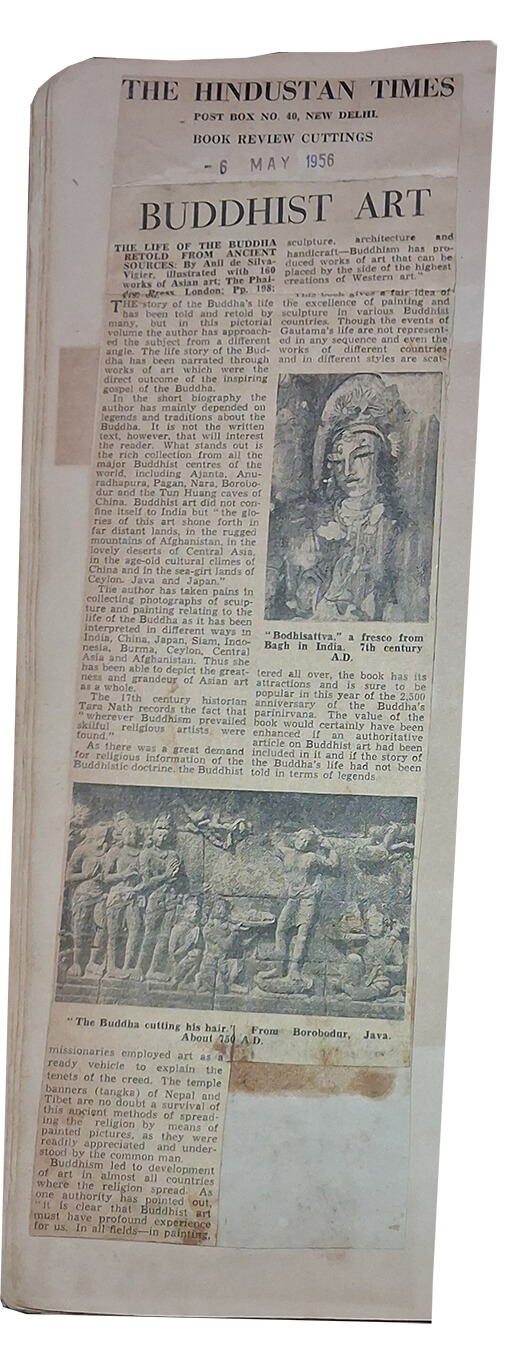
Photo-1: "Bodhisattva," a fresco from Bagh in India. 7th century A.D.
Photo-2: "The Buddha cutting his hair." From Borobodur, Java. About 750 A.D.
The Hindustan Times, May 06, 1956
BUDDHIST ART
LIFE OF THE BUDDHA FROM ANCIENT SOURCE
By Anil de Silva-Vigier
The Phaidon Press, London
illustrated with 160 works of Asian art; Pp. 198
THE story of the Buddha's life has been told and retold by many, but in this pictorial volume the author has approached the subject from a different angle. The life story of the Buddha has been narrated through works of art which were the direct outcome of the inspiring gospel of the Buddha. In the short biography the author has mainly depended on legends and traditions about the Buddha. It is not the written text, however, that will interest the reader. What stands out is the rich collection from all the major Buddhist centres of the world, including Ajanta, Anuradhapura, Pagan, Nara, Borobodur and the Tun Huang caves of China. Buddhist art did not confine itself to India but "the glories of this art shone forth in far distant lands, in the rugged mountains of Afghanistan, in the lovely deserts of Central Asia, in the age-old cultural climes of China and in the sea-girt lands of Ceylon, Java and Japan." The author has taken pains in collecting photographs of sculpture and painting relating to the life of the Buddha as it has been interpreted in different ways in India, China, Japan, Siam, Indonesia, Burma, Ceylon, Central Asia and Afghanistan. Thus she has been able to depict the greatness and grandeur of Asian art as a whole. The 17th century historian Tara Nath records the fact that "wherever Buddhism prevailed, religious artists were found." As there was a great demand for religious information of the Buddhistic doctrine, the Buddhist missionaries employed art as a ready vehicle to explain the tenets of the creed. The temple banners (tangka) of Nepal and Tibet are no doubt a survival of this ancient method of spreading the religion by means of painted pictures, as they were readily appreciated and understood by the common man. Buddhism led to development of art in almost all countries where the religion spread. As one authority has pointed out, "It is clear that Buddhist art must have profound experience for us. In all fields—in painting, sculpture and handicraft—Buddhism has produced works of art that can be placed by the side of the highest creations of Western art. This book gives a fair idea of the excellence of painting and sculpture in various Buddhist countries. Though the events of Gautama's life are not represented in any sequence and even the works of different countries and in different styles are scattered all over, the book has its attractions and is sure to be popular in this year of the 2,500th anniversary of the Buddha's parinirvana. The value of the book would certainly have been enhanced if an authoritative article on Buddhist art had been included in it and if the story of the Buddha's life had not been told in terms of legends.
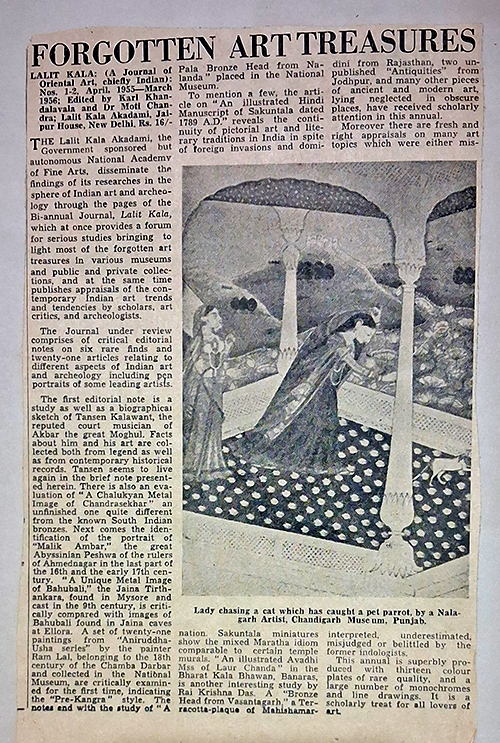
"Lady Chasing a Cat that has Caught a Pet Parrot by a Nalagarh artist", now in the Chandigarh Museum
The Hindustan Times, 1956
FORGOTTEN ART TREASURES
LALIT KALA (A Journal of Oriental Art, chiefly Indian)
Nos. 1–2
April 1955 – March 1956
Edited by Karl Khandalavala and Dr. Moti Chandra
Published by the Lalit Kala Akademi, Jaipur House, New Delhi
Price: Rs 16
The Lalit Kala Akademi, the government-sponsored but autonomous National Academy of Fine Arts, publishes the findings of its research in Indian art and archaeology through its bi-annual journal Lalit Kala. This publication provides a serious forum for scholarly studies, uncovering many forgotten art treasures from public and private collections, and offering critical appraisals of contemporary Indian art by leading scholars, critics, and archaeologists.
This inaugural double issue contains:
Six editorial notes on rare finds:
Twenty-one research articles on various aspects of ancient and modern Indian art and archaeology
Pen-portraits of leading artists
The opening editorial is both a study and biographical sketch of Tansen Kalawant, the famed court musician of Akbar the Great. Drawing from both legend and contemporary records, the article brings Tansen vividly to life.
Other notable contributions include:
A critical study of a Chalukyan metal image of Chandrasekhar—unfinished and quite distinct from typical South Indian bronzes.
Identification of a portrait of Malik Ambar, the Abyssinian Peshwa of the Ahmednagar rulers in the 16th–17th centuries.
Examination of a unique metal image of Bahubali (Jain Tirthankara) from Mysore, dated to the 9th century, compared with other Bahubali images at Ellora.
Analysis of 21 miniature paintings from the Aniruddha-Usha series by Ram Lal, an 18th-century Chamba court painter—considered "Pre-Kangra" style.
Evaluation of an illustrated Hindi manuscript of Shakuntala (1789 A.D.), highlighting the continuity of Indian pictorial and literary traditions despite centuries of foreign invasion and cultural disruption.
Appraisal of an illustrated Avadhi manuscript of Laur Chanda from Bharat Kala Bhavan, Banaras, by Rai Krishna Das—featuring bold colours and dramatic compositions.
Notes on terracotta plaques, a bronze head from Vasantgarh, and unpublished antiquities from Rajasthan and Jodhpur.
The volume is superbly produced, with:
Thirteen colour plates of excellent quality
Numerous monochrome photographs and line drawings
This annual journal is a scholarly treat for all lovers of Indian art. It sheds light on underestimated topics, and corrects earlier misjudgments made by some former indologists. In both content and production, it upholds a high standard and deserves a wide readership
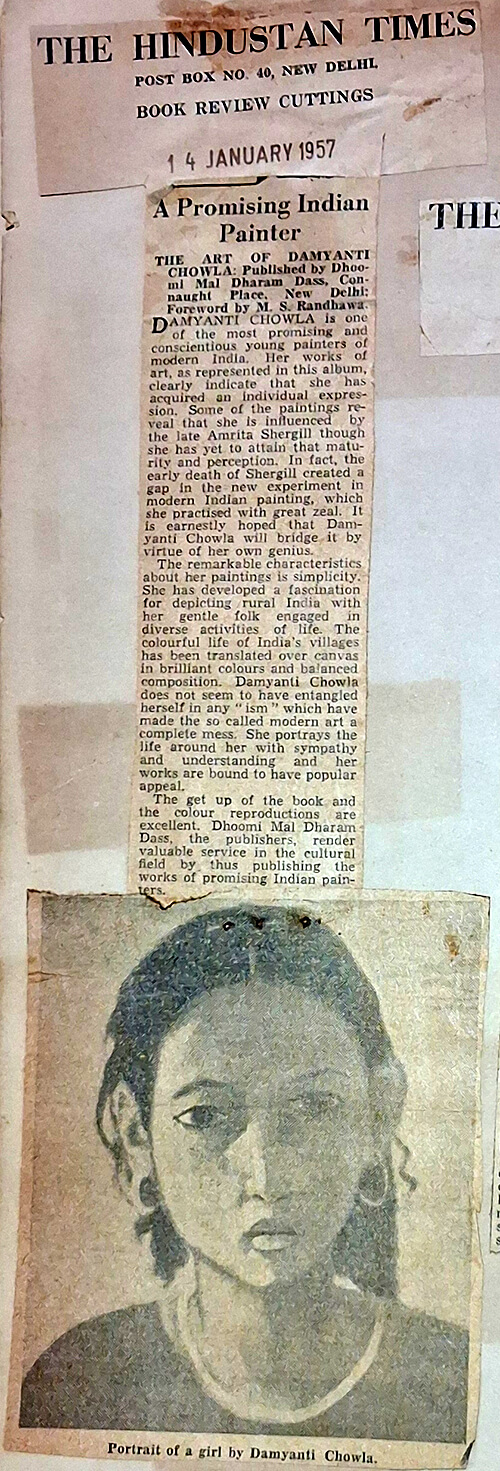
Portrait of a Girl by Damyanti Chowla
The Hindustan Times, January 01, 1957
A Promising Indian Painter
The Art of Damyanti Chowla
Published by Dhoomi Mal Dharam Dass, Connaught Place, New Delhi
Foreword by M. S. Randhawa
Damyanti Chowla is one of the most promising and conscientious young painters of modern India. Her works, as represented in this album, clearly indicate that she has already acquired a distinct individual expression. Some of the paintings suggest an influence of the late Amrita Sher-Gil, although Damyanti has yet to attain that level of maturity and depth of perception. The untimely death of Sher-Gil left a void in the new movement of experimental modern Indian painting—a movement she had pursued with great dedication. It is earnestly hoped that Damyanti Chowla, by virtue of her own artistic insight and originality, may carry that legacy forward. The most remarkable feature of her work is its simplicity. She has developed a strong fascination with rural India, often depicting gentle village folk engaged in daily life. The colourful vibrancy of India’s villages is captured on canvas through brilliant colour schemes and balanced compositions. Notably, Damyanti Chowla does not seem entangled in the many "isms" that have muddled much of so-called modern art. Instead, she paints the life around her with empathy, clarity, and understanding. Her works are bound to find a popular appeal for their sincerity and emotional resonance. The get-up of the book and the quality of colour reproductions are excellent. The publishers, Dhoomi Mal Dharam Dass, have rendered valuable service to the cultural field by publishing and promoting the works of promising Indian painters.
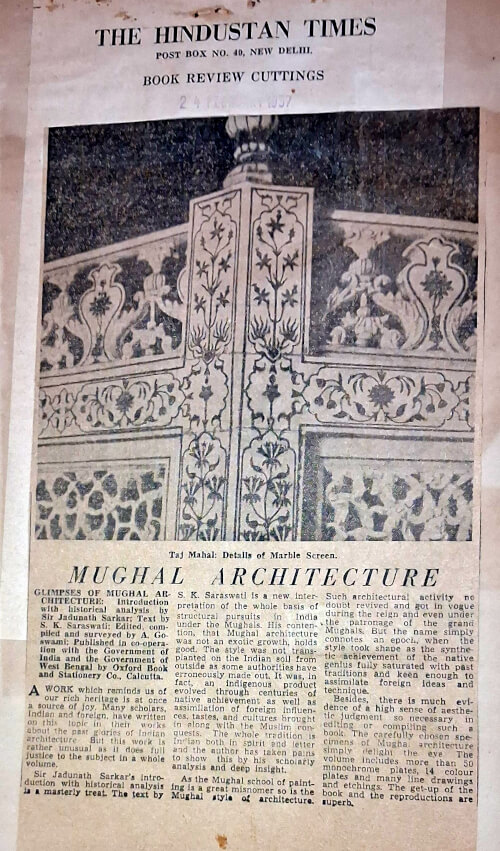
Taj Mahal: Details of Marble Screen
The Hindustan Times, February 02, 1957
MUGHAL ARCHITECTURE
Glimpses of Mughal Architecture
Historical analysis by Sir Jadunath Sarkar
Text by S. K. Saraswati
Edited, compiled, and surveyed by A. Goswami
Published in co-operation with the Government of India and the Government of West Bengal
By Oxford Book and Stationery Co., Calcutta
A work that reminds us of our rich heritage is at once a source of joy. Many scholars, both Indian and foreign, have written on this topic, reflecting on the past glories of Indian architecture. But this particular volume is unusual—it does full justice to the subject in a comprehensive and cohesive manner. The Introduction by Sir Jadunath Sarkar, complete with historical analysis, is a masterly treat. The main text by S. K. Saraswati presents a new interpretation of the very basis of architectural development in India during the Mughal period. Saraswati challenges the commonly held view that Mughal architecture was a foreign or exotic growth transplanted onto Indian soil. Instead, he argues that it was a truly indigenous product, evolved over centuries through a complex process of assimilation of foreign influences, tastes, and cultures brought in by Muslim conquests. The tradition remained Indian in both spirit and letter, and the author takes great pains to show this through his scholarly analysis and deep insight. Just as the label “Mughal school of painting” is a broad designation for an epoch and not a rigid stylistic category, “Mughal architecture” too is a misnomer if taken to mean something alien. Rather, it marks a period in which the architectural style matured—blending native genius with a readiness to absorb and reinterpret external ideas and techniques. The volume contains more than 50 monochrome plates, 14 colour plates, and numerous line drawings and etchings. The editorial team has shown a keen aesthetic sense in curating these specimens. The result is a visually delightful and intellectually enriching volume. The format, production quality, and reproductions are all superb. This is not merely a survey but a thoughtful interpretation—a valuable contribution to the understanding of Indian architectural history.
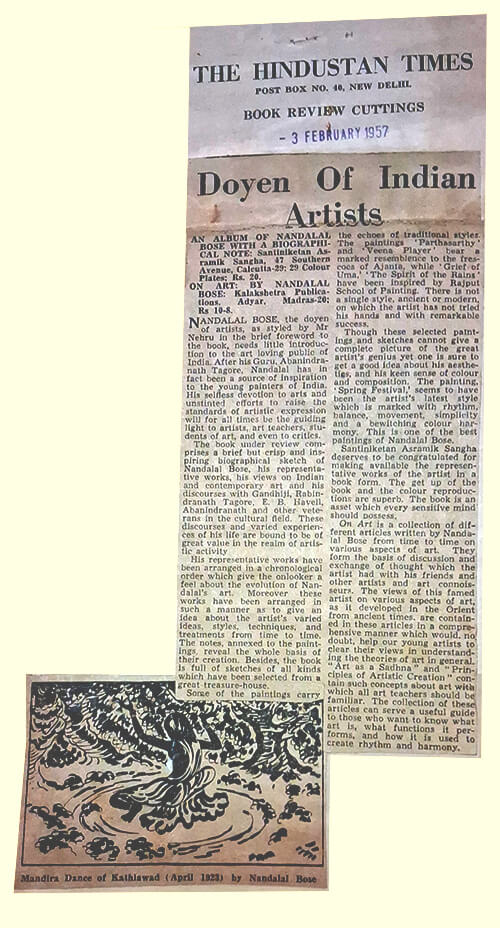
The Hindustan Times, February 03, 1957
Doyen of Indian Artists
On Art by Nandalal Bose
An Album of Nandalal Bose with a Biographical Note
Kalakshetra Publications, Adyar, Madras-20
Santiniketan Asramik Sangha, 47 Southern Avenue, Calcutta-29
29 Colour Plates: Rs. 20; Rs. 10-8.
Nandalal Bose, the doyen of artists—as styled by Mr. Nehru in the brief foreword to the book—needs little introduction to the art-loving public of India. After his guru, Abanindranath Tagore, Nandalal has in fact been a source of inspiration to the young painters of India. His selfless devotion to the arts and unstinted efforts to raise the standards of artistic expression will, for all time, be a guiding light to artists, art teachers, students of art, and even to critics. The book under review comprises a brief but crisp and inspiring biographical sketch of Nandalal Bose, his representative works, his views on Indian and contemporary art, and his discourses with Gandhiji, Rabindranath Tagore, E.B. Havell, Abanindranath, and other veterans in the cultural field. These discourses and varied experiences of his life are bound to be of great value in the realm of artistic activity. His representative works have been arranged in a chronological order, which gives the onlooker a sense of the evolution of Nandalal’s art. The paintings have been arranged in such a manner as to reflect the artist’s varied ideas, styles, techniques, and treatments from time to time. The notes annexed to the paintings help clarify the theories of art in general. Essays like Art as a Sadhana and Principles of Artistic Creation contain such concepts about art with which all art teachers should be familiar. The collection of these articles can serve as a useful guide to those who want to understand what art is, what functions it performs, and how it is used to create rhythm and harmony. Some of the paintings carry the echoes of traditional styles. Parthasarthy and Veena Player bear a marked resemblance to the frescoes of Ajanta, while Grief of Uma and The Spirit of the Rains have been inspired by the Rajput school of painting. There is not a single style—ancient or modern—on which the artist has not tried his hand, and with remarkable success. Though these selected paintings and sketches cannot offer a complete picture of the great artist’s genius, one is sure to get a good idea of his aesthetics, his keen sense of colour, and his compositional strength. The painting Spring Festival appears to represent the artist’s latest style, marked by rhythm, balance, movement, simplicity, and a bewitching colour harmony. This is one of the best paintings of Nandalal Bose. Santiniketan Asramik Sangha deserves to be congratulated for making available the representative works of the artist in book form. The get-up of the book and the colour reproductions are superb. The book is an asset that every sensitive mind should possess. On Art is a collection of different articles written by Nandalal Bose from time to time on various aspects of art. They form the basis of discussion and exchange of thought which the artist had with his friends, other artists, and art connoisseurs. His views on various aspects of art, especially as developed in the Orient since ancient times, are contained in these articles in a comprehensive manner, which will no doubt help young artists clarify their thinking and understand the very basis of their creative activity. Besides, the book is full of sketches of all kinds, selected from a great treasure-house.
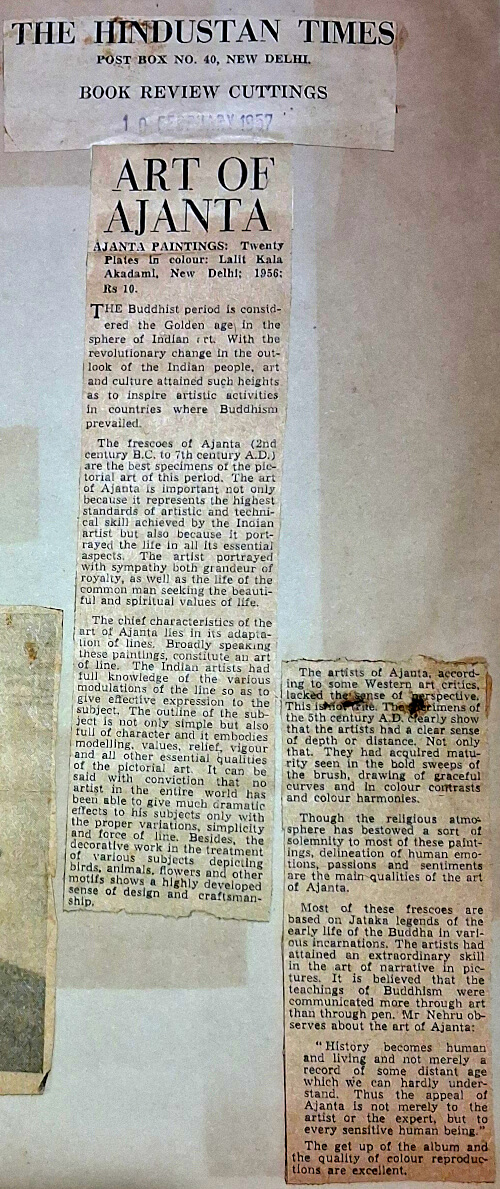
The Hindustan Times, February 10, 1957
Art of Ajanta
Ajanta Paintings
Published by Lalit Kala Akademi, New Delhi, 1956
Twenty Plates in Colour
Price: ₹10
The Buddhist period is considered the golden age in the history of Indian art. With a revolutionary shift in the spiritual and philosophical outlook of the Indian people, art and culture soared to new heights—so much so that Indian artistic influence inspired creative activity in many countries where Buddhism prevailed. The frescoes of Ajanta (dating from 2nd century B.C. to 7th century A.D.) are among the finest examples of the pictorial art of this period. These murals are significant not only for the technical and aesthetic excellence they display, but also because they portray life in all its essential aspects—from the grandeur of royalty to the spiritual yearnings of the common man. The chief characteristic of Ajanta art lies in its mastery of line. These paintings, broadly speaking, are an art of line. The Indian artist had a full and subtle understanding of how to modulate line to convey expression, emotion, form, and movement. The outlines are simple yet powerful, embodying modelling, values, relief, and dynamism—all essential components of great pictorial art. It can be said with conviction that no artist in the world has used line with such dramatic effect, achieved through variation, simplicity, and force. In addition, the decorative treatment of motifs—birds, animals, flowers, and patterns—shows an advanced sense of design and craftsmanship. Some Western art critics have claimed that Ajanta painters lacked an understanding of perspective. This is not accurate. The murals of the 5th century A.D. clearly demonstrate that the artists had a well-developed sense of spatial depth and distance. Moreover, they showed a mature command in the bold sweep of the brush, the graceful curves of drawing, and the use of colour contrasts and harmonies. Though many paintings are set in a religious atmosphere, giving them a certain solemnity, it is the depiction of human emotions, passions, and sentiments that forms the core strength of Ajanta’s artistic legacy. Most of the frescoes are based on the Jataka tales—legends of the Buddha’s previous incarnations. The artists demonstrated exceptional skill in narrative art, telling complex stories vividly through imagery. It is said that Buddhist teachings were often communicated more effectively through art than through text. In the words of Jawaharlal Nehru, writing on the significance of Ajanta: "History becomes human and living and not merely a record of some distant age which we can hardly understand. Thus, the appeal of Ajanta is not merely to the artist or the expert, but to every sensitive human being." The get-up of the album and the quality of colour reproductions are excellent, making this an outstanding publication by the Lalit Kala Akademi.
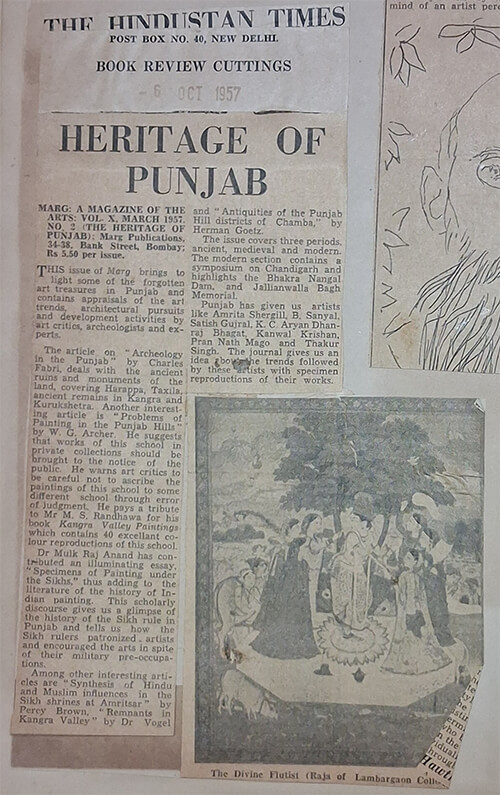
The Divine Flutist
The Hindustan Times, October 06, 1957
HERITAGE OF PUNJAB
MARG: A MAGAZINE OF THE ARTS
Vol. X, No. 2
The Heritage of Punjab
March 1957
Marg Publications, 34–38 Bank Street, Bombay
Rs 5.50 per issue
This issue of Marg brings to light some of the forgotten art treasures of Punjab and offers valuable appraisals of art trends and development activities by art critics, archaeologists, and other experts. The issue covers three major periods—ancient, medieval, and modern. The ancient section includes: “Archaeology in the Punjab” by Charles Fabri, discussing ancient ruins and monuments at Harappa, Taxila, Kurukshetra, and the Kangra region. “Antiquities of the Punjab Hill Districts of Chamba” by Herman Goetz. In the medieval and painting-focused sections: “Problems of Painting in the Punjab Hills” by W. G. Archer, which stresses the need to bring private collections of Punjab Hill paintings into public view. Archer cautions critics against misattributing works and commends M. S. Randhawa for his book Kangra Valley Paintings, which contains 40 excellent colour reproductions of this school. Dr. Mulk Raj Anand contributes an illuminating essay titled “Specimens of Painting under the Sikhs”, adding richly to the literature on Indian art. He shows how Sikh rulers, despite their military focus, patronized and promoted the arts. The modern section contains: A symposium on Chandigarh, highlighting its architectural development. Features on the Bhakra Nangal Dam and Jallianwalla Bagh Memorial, placing them in the larger cultural heritage of Punjab. Additional articles include: “Synthesis of Hindu and Muslim Influences in the Sikh Shrines at Amritsar” by Percy Brown. “Remnants in the Kangra Valley” by Dr. Vogel. Punjab’s contribution to modern Indian art is also documented, with reference to artists such as Amrita Sher-Gil, B. Sanyal, Satish Gujral, K. C. Aryan, Dhanraj Bhagat, Kanwal Krishan, Pran Nath Mago, and Thakur Singh. The journal traces their artistic trends and includes specimens of their works.
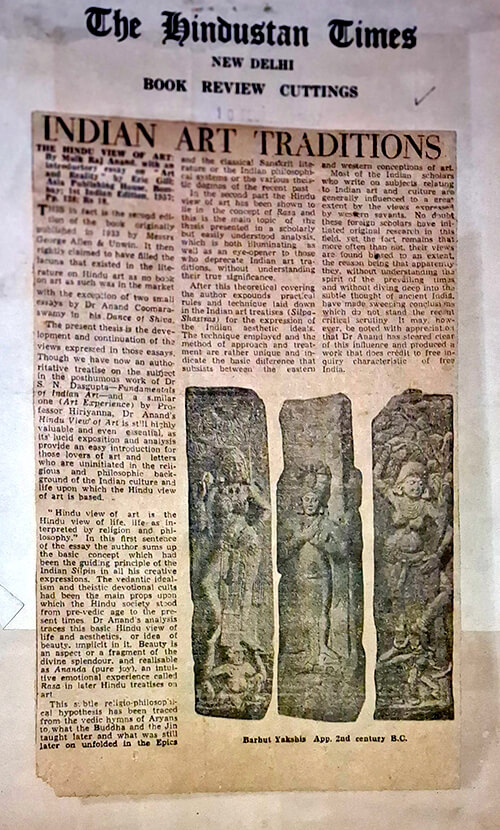
Barhut Yakshi App. 2nd century B.C
The Hindustan Times, October 10, 1957
Indian Art Traditions
THE HINDU VIEW OF ART
By Mulk Raj Anand
With an Introductory Note by G. Venkatachalam
Originally published 1933 by Messrs George Allen & Unwin
Reprint reviewed here
In the first sentence of the essay, the author sums up the basic concept which had been the guiding principle of the Indian śilpin (artist/artisan) in all his creative expressions: "The Hindu view of art is the Hindu view of life—life as interpreted by religion and philosophy." The Vedantic idealism and theistic devotional cults were the main props upon which Hindu society stood—from the pre-Vedic age to the present times. Dr. Anand’s analysis traces this basic Hindu view of life and aesthetics, or the idea of beauty implicit in it. Beauty is seen as an aspect or fragment of the divine splendour, and is realized as Ananda (pure joy)—an intuitive emotional experience called Rasa in later Hindu treatises on art. This subtle religio-philosophical hypothesis has been traced from the Vedic hymns of the Aryans to what the Buddha and the Jina taught later, and what was still later unfolded in the Epics and the classical Sanskrit literature and the Indian philosophical systems. In the second part of the book, the Hindu view of art has been shown to lie in the concept of Rasa, and this becomes the main topic of the thesis. Originally published in 1933, the book rightly claimed to have filled a lacuna that existed in literature on Hindu art, as no book on art as such was then in the market—except two small essays by Dr. Ananda Coomaraswamy in his Dance of Shiva. The present thesis is the development and continuation of the views expressed in those essays. The technique employed and the method of approach and treatment are rather unique and individualistic, yet the fact remains that more often than not, the views of Indian scholars—especially those writing on Indian art and culture—have been influenced to a great extent by Western thought. No doubt, these foreign scholars have initiated original research, but they, without understanding the spirit of the prevailing times or the subtle thought of ancient India, have made sweeping conclusions which do not stand up to recent critical scrutiny. It may, however, be noted with appreciation that Dr. Anand has steered clear of this influence and produced a work that does credit to the spirit of free inquiry characteristic of Indian aesthetics. After the theoretical coverage, the author expounds practical rules and technique laid down in the Indian art treatises (Śilpaśāstras) for the expression of the Indian aesthetic ideals. This is a highly valuable and even essential work, as its lucid exposition and analysis provide an easy introduction for lovers of art and letters who are uninformed in the religious and philosophical background of Indian culture and life—upon which the Hindu view of art is based. Symbolic Art and Its Spiritual Foundations This is symbolic art. It is not a sudden development unrelated to the life of Northern India, but rather the culmination of a spiritual and literary revival of Hinduism. Dr. Anand emphasizes the difference between Eastern and Western conceptions of art, and how Indian art must be understood on its own aesthetic and spiritual terms.
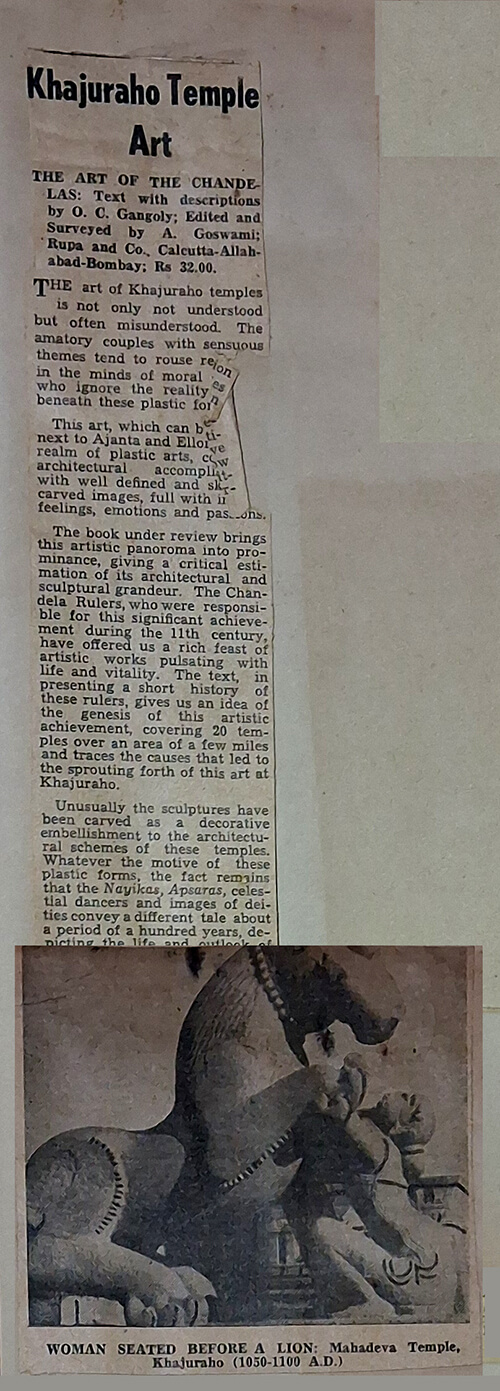
Seated Before a Lion – Mahadeva Temple, Khajuraho (1050–1100 A.D.)
The Hindustan Times, 1957
Khajuraho Temple Art
THE ART OF THE CHANDELAS
Text with descriptions by O. C. Gangoly
Edited and Surveyed by A. Goswami
Published by Rupa & Co., Calcutta–Allahabad–Bombay
Price: Rs. 32.00
The art of the Khajuraho temples is not only not understood — it is often misunderstood. The amatory couples and sensuous themes tend to provoke revulsion in the minds of moralists, who ignore the deeper reality beneath these plastic forms. This art — which rightfully stands next to Ajanta and Ellora in the realm of Indian plastic arts — is an architectural accomplishment, filled with finely carved images that embody feeling, emotion, and passion. The book under review brings this artistic panorama into prominence, offering a critical assessment of both its architectural and sculptural grandeur. The Chandela rulers, responsible for this remarkable achievement during the 11th century, have gifted us a rich legacy of artistic expression pulsating with life and vitality. The text provides a concise history of the Chandela rulers, offering insight into the genesis of this cultural flowering. It covers the creation of 20 temples within a small geographic area and explores the causes that led to the emergence of this distinctive art form at Khajuraho. Unusually, the sculptures have been carved as decorative elements fully integrated into the architectural design of the temples. Whatever the intended symbolism of these plastic forms, the fact remains that the Nayikas, Apsaras, celestial dancers, and divine figures portrayed here narrate a different story — one that spans a hundred years, depicting the life, values, and worldview of that time.
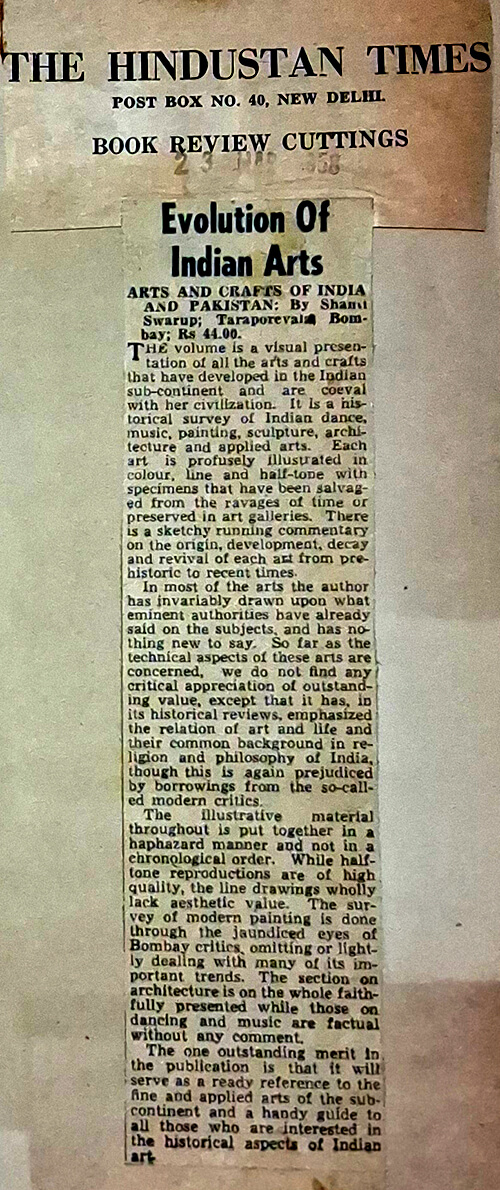
The Hindustan Times, March 23, 1958
Evolution of Indian Arts
Arts and Crafts of India and Pakistan
by Shanti Swarup; Taraporevala, Bombay
Price: Rs 44.00
The volume is a visual presentation of all the arts and crafts that have developed in the Indian sub-continent, and are coeval with her civilization. It is a historical survey of Indian dance, music, painting, sculpture, architecture and applied arts. Each art is profusely illustrated in colour, line and half-tone with specimens that have been salvaged from the ravages of time or preserved in art galleries. There is a sketchy running commentary on the origin, development, decay and revival of each art from prehistoric to recent times. In most of the arts the author has invariably drawn upon what eminent authorities have already said on the subjects, and has nothing new to say. So far as the technical aspects of these arts are concerned, we do not find any critical appreciation of outstanding value, except that it has, in its historical reviews, emphasized the relation of art and life and their common background in religion and philosophy of India, though this is again prejudiced by borrowings from the so-called modern critics. The illustrative material throughout is put together in a haphazard manner and not in a chronological order. While half-tone reproductions are of high quality, the line drawings wholly lack aesthetic value. The survey of modern painting is done through the jaundiced eyes of Bombay critics, omitting or lightly dealing with many of its important trends. The section on architecture is on the whole faithfully presented while those on dancing and music are factual without any comment. The one outstanding merit in the publication is that it will serve as a ready reference to the fine and applied arts of the subcontinent and a handy guide to all those who are interested in the historical aspects of Indian art.
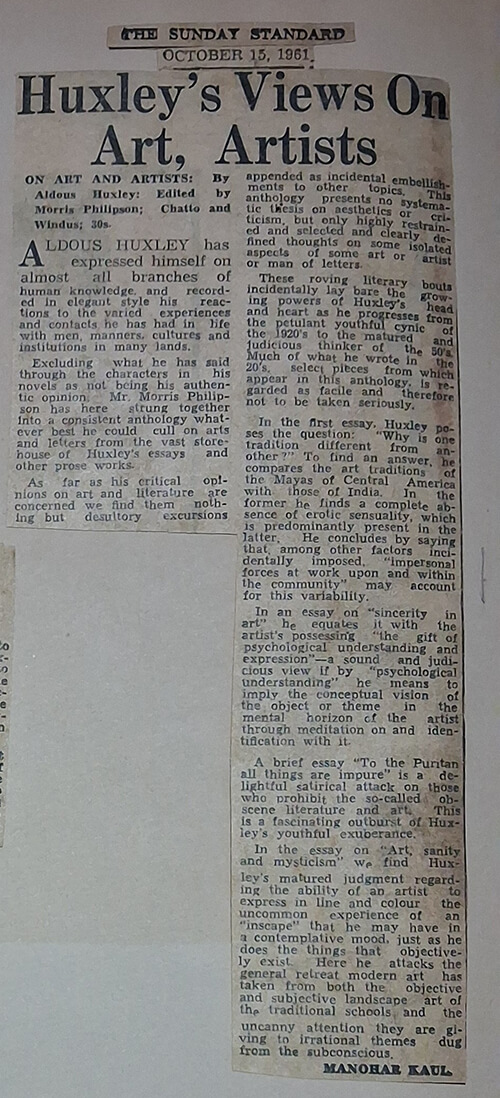
The Hindustan Times, October 15, 1961
Huxley’s Views on Art and Artists
ON ART AND ARTISTS
By Aldous Huxley
Edited by Morris Philipson
Chatto and Windus; 30s
Aldous Huxley has expressed himself on almost every branch of human knowledge. And in elegant style, he has recorded his varied experiences and contacts with men, manners, cultures, and institutions across many lands. Excluding what he has said through characters in his novels (as not being his authentic opinions), Morris Philipson has here strung together into a consistent anthology whatever best he could cull on arts and letters from the vast storehouse of Huxley’s essays and other prose works. As far as his critical opinions on art and literature are concerned, we find them desultory excursions, appended more as incidental embellishments to other topics than as sustained theses on aesthetics or criticism. This anthology presents no systematic thesis, but rather highly restrained, selected, and clearly defined thoughts on isolated aspects of certain arts or artists and writers. These roving literary bouts nevertheless lay bare the growing powers of Huxley’s mind and heart, as he progresses from the petulant, youthful cynic of the 1920s to the matured, judicious thinker of the 1950s. Much of what he wrote in the 1920s, which appears in this anthology, is regarded as facile and not to be taken seriously. In the first essay, Huxley poses the question: “Why is one tradition different from another?” To answer it, he compares the art traditions of the Mayas of Central America with those of India. In the former, he finds a complete absence of erotic sensuality, while the latter is predominantly steeped in it. He concludes that, among other factors, “impersonal forces at work upon and within the community” may account for this variability. In an essay on “Sincerity in Art”, he equates sincerity with the artist's possession of “the gift of psychological understanding and expression.” This is a sound and judicious view—if by "psychological understanding" he means a conceptual vision of the object or theme, gained through meditation and identification with it. A brief essay titled “To the Puritan all things are impure” is a delightful satirical attack on those who prohibit so-called obscene literature and art—an outburst of Huxley’s youthful exuberance. In the essay on “Art, Sanity, and Mysticism”, we encounter Huxley’s mature judgment about the artist’s ability to express, in line and colour, uncommon experiences of ‘inscape’—those arising in contemplative moods, just as he does the things that objectively exist. Here, he attacks the general retreat of modern art from both objective and subjective landscape traditions, and the uncanny attention it gives to irrational themes dredged from the subconscious.
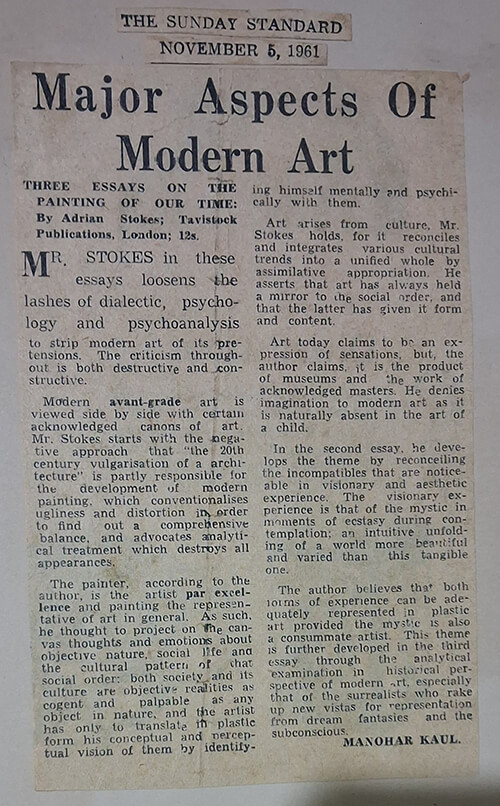
The Hindustan Times, November 05, 1961
Major Aspects of Modern Art
THREE ESSAYS ON THE PAINTING OF OUR TIME
By Adrian Stokes
Tavistock Publications, London; 12s.
Mr. Stokes, in these essays, loosens the lashes of dialectic, psychology, and psychoanalysis to strip modern art of its pretensions. The criticism throughout is both destructive and constructive. Modern avant-garde painting is reviewed side by side with certain acknowledged canons of art. Mr. Stokes starts with the negative approach that the "20th-century vulgarisation of architecture" is partly responsible for modern painting—painting which conventionalises ugliness and distortion in order to find a new comprehensive balance, and which advocates analytical treatment that destroys appearances in the process. The painter, according to the author, is the artist par excellence, and painting is the representative of art in general. As such, the painter is expected to project onto the canvas thoughts and emotions about objective nature, social life, and cultural patterns of a given social order. Both society and its culture are objective realities, as cogent and palpable as any object in nature. The artist, therefore, has only to translate into plastic form his conceptual and perceptual vision of them by identifying himself mentally and psychically with these realities. Mr. Stokes holds that art arises from culture, for it reconciles and integrates various cultural trends into a unified whole by assimilative appropriation. He asserts that art has always held a mirror to the social order, and that the social order in turn has always given art its form and content. Art today claims to be an expression of sensations, but the author argues it is more often the product of museums and the legacy of acknowledged masters. He denies imagination to modern art, claiming that imagination is as naturally absent in modern art as it is in the art of a child. In the second essay, Stokes develops this theme by reconciling the incompatibles that are noticeable in visionary and aesthetic experience. The visionary experience is that of the mystic, in moments of ecstasy during contemplation—an intuitive unfolding of a world more beautiful than the tangible. The author believes that both forms of experience—aesthetic and visionary—can be adequately represented in plastic art, provided the mystic is also a consummate artist. This theme is further developed in the third essay, through an analytical examination in historical perspective of modern art, especially that of the surrealists, who rake up new vistas for representation drawn from dream fantasies and the subconscious.
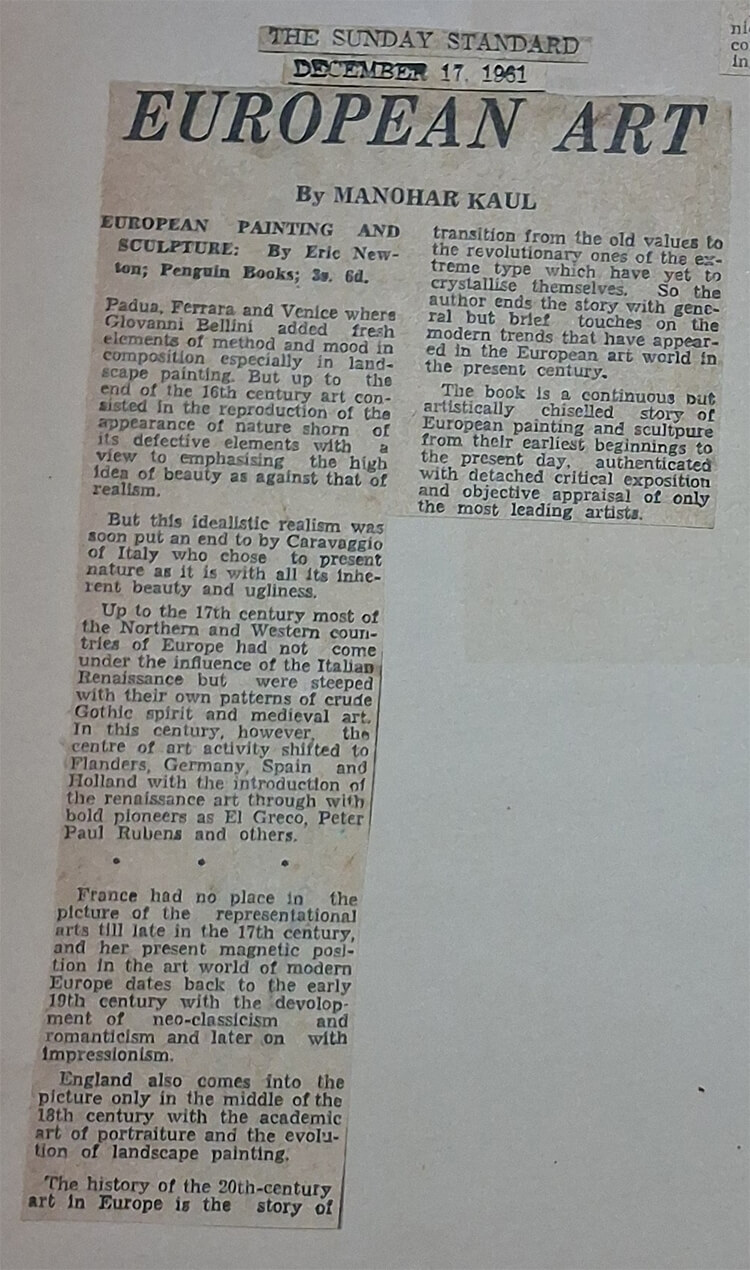
The Hindustan Times, December 17, 1961
EUROPEAN ART
EUROPEAN PAINTING AND SCULPTURE
By Eric Newton
Penguin Books; 3s. 6d.
Padua, Ferrara and Venice where Giovanni Bellini added fresh elements of method and mood in composition especially in landscape painting. But up to the end of the 16th century art consisted in the reproduction of the appearance of nature shorn of its defective elements with a view to emphasising the high idea of beauty as against that of realism. But this idealistic realism was soon put an end to by Caravaggio of Italy who chose to present nature as it is with all its inherent beauty and ugliness. Up to the 17th century most of the Northern and Western countries of Europe had not come under the influence of the Italian Renaissance but were steeped with their own patterns of crude Gothic spirit and medieval art. In this century, however, the centre of art activity shifted to Flanders, Germany, Spain and Holland with the introduction of the renaissance art through with bold pioneers as El Greco, Peter Paul Rubens and others. France had no place in the picture of the representational arts till late in the 17th century, and her present magnetic position in the art world of modern Europe dates back to the early 19th century with the development of neo-classicism and romanticism and later on with Impressionism. England also comes into the picture only in the middle of the 18th century with the academic art of portraiture and the evolution of landscape painting. The history of the 20th-century art in Europe is the story of transition from the old values to the revolutionary ones of the extreme type which have yet to crystallise themselves. So the author ends the story with general but brief touches on the modern trends that have appeared in the European art world in the present century. The book is a continuous but artistically chiselled story of European painting and sculpture from their earliest beginnings to the present day, authenticated with detached critical exposition and objective appraisal of only the most leading artists.
